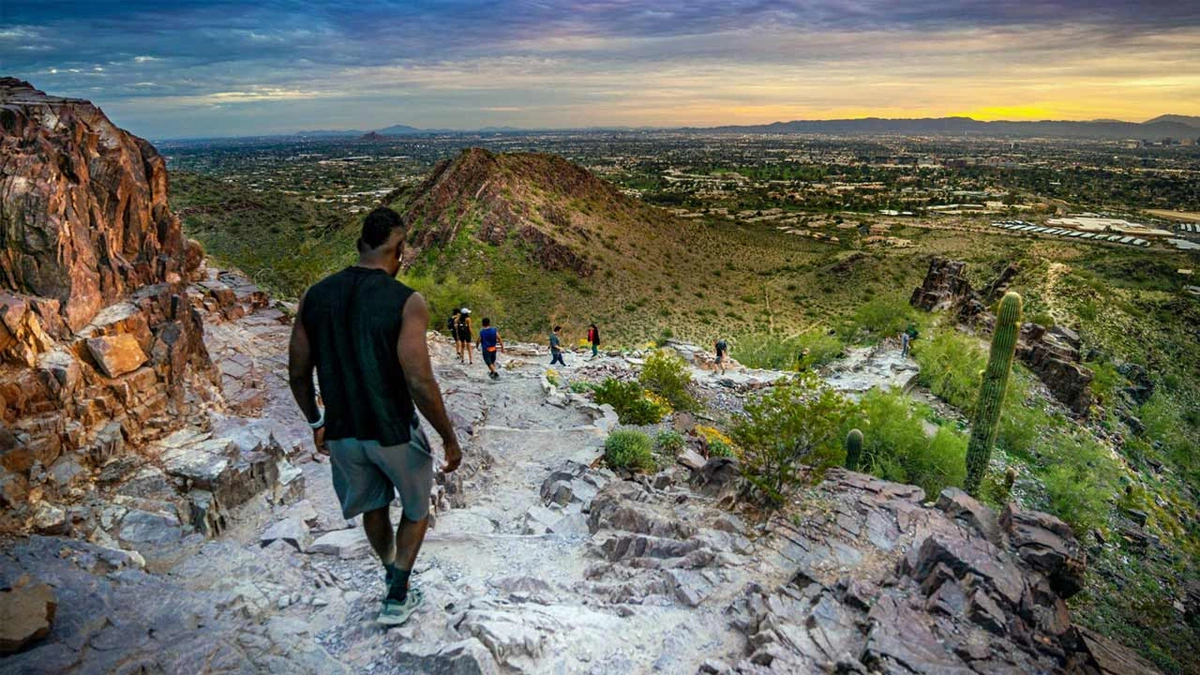Phoenix weather . Ah, it’s a phrase that conjures up images of scorching summers and, well, more sunshine. But here’s the thing: it’s way more nuanced than that. Let’s be honest, understanding the desert climate can be tricky. It’s not just about packing light clothes and sunglasses. It’s about anticipating the unpredictable, like those sneaky monsoon storms. So, forget the generic forecasts – we’re diving deep into the heart of what makes the Phoenix climate tick.
The Scorching Summers | A Survival Guide

Okay, let’s address the elephant in the room – or rather, the sun in the sky. Phoenix summers are legendary. We’re talking triple-digit temperatures that can melt your flip-flops to the pavement. But it’s not just the heat; it’s the dry heat. Which, yes, is technically “better” than humid heat, but trust me, after 110°F, semantics go out the window.
A common mistake I see people make is underestimating the power of hydration. It’s not enough to drink water when you feel thirsty. You need to be constantly sipping throughout the day. Electrolytes are your friends, too! And remember, avoid strenuous activities during peak hours. Unless you’re a lizard, in which case, carry on.
But even with all the precautions, sometimes heat exhaustion happens. Know the symptoms: dizziness, nausea, headache. If you experience these, get to a cool place immediately and seek medical attention if needed. Seriously, don’t tough it out.
Monsoon Season | When the Desert Gets Dramatic
Just when you think you’ve got the Phoenix weather pattern figured out, Mother Nature throws a monsoon at you. Typically running from mid-June to the end of September, monsoon season brings dramatic thunderstorms, intense rain, and… dust storms (haboobs, if you want to sound like a local).
These storms can be beautiful, terrifying, and incredibly disruptive, all at the same time. Flash flooding is a real danger, so avoid low-lying areas during heavy rainfall. And be prepared for power outages – it’s always a good idea to have a backup plan. The stormsare no joke.
What fascinates me is the sudden shift in the landscape. One minute it’s dry and dusty, the next it’s lush and green. The desert comes alive after a good rain, and it’s truly a sight to behold.
The Mild Winters | A Desert Oasis
After enduring the summer heat, Phoenix rewards you with glorious winters. We’re talking sunny days, clear skies, and temperatures that are perfect for outdoor activities. It’s no wonder so many people flock to Phoenix during the winter months – it’s an escape from the cold and snow. I remember one winter, I could go hiking in shorts and t-shirt!
But even in winter, the desert can surprise you. Nighttime temperatures can drop significantly, so it’s always a good idea to have a jacket or sweater handy. And while snow is rare, it does happen! Just don’t expect a white Christmas. Still you can check other place like Los Angeles for better comparison.
The average temperature can fluctuate so drastically between daytime and nighttime.
Understanding the Microclimates
Here’s where things get interesting. Phoenix isn’t just one homogenous blob of desert; it’s a collection of microclimates. What does that mean? Well, the temperature and weather conditions can vary significantly depending on where you are in the city.
For example, areas closer to the mountains tend to be cooler and receive more rainfall than those in the valley. And the urban heat island effect can make downtown Phoenix significantly warmer than surrounding areas. It’s like having multiple seasons within a single city!
So, before you head out for the day, it’s always a good idea to check the forecast for your specific location. Don’t just rely on the general Phoenix weather report – dig a little deeper.
Preparing for Phoenix’s Unique Weather Challenges
Living in Phoenix means adapting to its unique weather challenges. It’s not just about surviving the heat; it’s about thriving in it. Here are a few tips to keep in mind:
- Sun Protection: Sunscreen, hats, and sunglasses are essential year-round.
- Hydration: Drink plenty of water, even when you’re not thirsty.
- Home Maintenance: Ensure your AC is working efficiently and your home is properly insulated.
- Vehicle Care: Keep your car well-maintained and check your tire pressure regularly.
- Emergency Preparedness: Have a plan in place for extreme weather events, such as dust storms and flash floods. According to the National Weather Service , these events require proactive safety measures.
FAQ | Decoding Phoenix Weather Quirks
What’s the best time of year to visit Phoenix?
October through April offers the most pleasant temperatures in Phoenix , ideal for outdoor activities.
How do I prepare for a dust storm in Phoenix?
Stay indoors, close windows and doors, and avoid driving if possible. If you must drive, reduce speed and use headlights.
What’s the urban heat island effect?
It’s when urban areas experience higher temperatures than surrounding rural areas due to human activities and infrastructure.
Is it really a dry heat?
Yes, Phoenix has low humidity, which makes the heat more bearable than in humid climates, but it’s still extremely hot.
What causes the monsoons?
Seasonal wind shifts bring moisture from the Gulf of Mexico and the Pacific Ocean, leading to thunderstorms and increased rainfall.
How accurate are Phoenix weather forecasts?
While generally reliable, microclimates can cause localized variations. Check hyper-local forecasts for the most accurate information.
So, there you have it – a deep dive into the wonderful, wacky world of Phoenix weather . It’s a climate that demands respect, preparation, and a sense of humor. But if you embrace its quirks, you’ll find that Phoenix is a truly remarkable place to live (or visit!). The desert climate is unique, and a vital part of the charm. It’s not just sunshine; it’s a whole experience. Don’t forget to stay aware of the current conditions !




